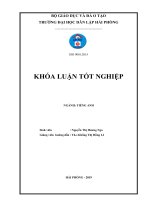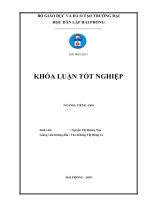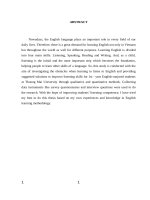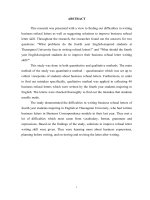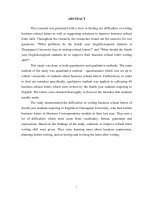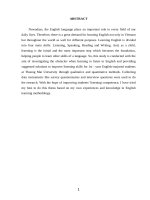Problems in english pronunciation of freshmen at english faculty of thuong mai university and some suggested solutions
Bạn đang xem bản rút gọn của tài liệu. Xem và tải ngay bản đầy đủ của tài liệu tại đây (600.57 KB, 51 trang )
ABSTRACT
This paper investigates what problems in English pronunciation are
encountered by English-majored freshmen at Thuong Mai University and suggests
the best solutions for their English pronunciation improvement.
To answer this question, the researcher needed the participation and
cooperation of 30 students from class K54N2 of Thuong Mai University. The
researcher used both qualitative and quantitative methods to collect and analyze
data from the participants. The qualitative method was applied to collect and
analyze the pronunciation errors in the recordings of the participants while the
quantitative method was used to accumulate information relating to pronunciation
levels, study methods and difficulties in pronouncing English sounds of those
students.
The results of this paper shown that the freshmen’s pronunciation levels
varied, but they all have encountered several problems in their English
pronunciation. The results revealed that they made a lot of mistakes or had troubles
when producing consonants, vowels and ending sounds. A number of strategies or
techniques to improve pronunciation were proposed and their effectiveness was
agreed by the participants.
It is hoped that this paper would help students recognize their pronunciation
problems and have suitable strategies to improve their pronunciation.
1
ACKNOWLEDGEMENTS
During the process of writing my graduate paper, I received many helps and
supports. First and foremost, I highly appreciate the assistance of my teacher, Ms.
Thanh Ha, for enthusiastically gave many significant instructions for my graduate
paper. Without her help, I cannot complete the paper accurately.
I am delighted to express my gratitude to English teachers at Thuong Mai
University for giving helpful courses and invaluable knowledge in this field of the
study.
Thanks to the cooperation of first-year students, especially those from N2
class, I collected sufficient data to conduct the research.
I look forward to your comments to improve my graduate paper and hope that
it will help freshmen as well as the other students at Thuong Mai University to
enhance their English.
Hanoi, March 7, 2019
Hoang Minh Giang
2
TABLE OF CONTENTS
ABSTRACT..............................................................................................................i
ACKNOWLEDGEMENTS....................................................................................ii
TABLE OF CONTENTS.......................................................................................iii
LIST OF ABBREVIATIONS..................................................................................v
LIST OF TABLES AND FIGURES......................................................................vi
CHAPTER 1: OVERVIEW OF THE STUDY......................................................1
1.1. Rationale...........................................................................................................1
1.2. Previous studies................................................................................................1
1.3. Aims of the study..............................................................................................3
1.4. Research subjects..............................................................................................3
1.5. Scope of the study.............................................................................................3
1.6. Research of methodology.................................................................................3
1.7. Organization of the study.................................................................................4
CHAPTER 2: LITERATURE REVIEW...............................................................5
2.1. Definition of pronunciation..............................................................................5
2.2. Standard English pronunciation.....................................................................5
2.3. Aspects of pronunciation..................................................................................6
2.3.1. Articulatory phonetics.....................................................................................6
2.3.2. English sounds................................................................................................7
2.3.3. Ending sounds..............................................................................................12
2.4. Common problems in pronunciation of Vietnamese people........................13
2.4.1. Problems with vowels....................................................................................13
2.4.2. Problems with consonants............................................................................14
2.5. Techniques to improve English pronunciation.............................................16
2.5.1. Doing pronunciation exercises.....................................................................16
2.5.2. Listening and imitating.................................................................................16
2.5.3. Reading aloud and clearly while recording produced sounds.....................17
2.5.4. Tongue twisters.............................................................................................17
2.6. Summary.........................................................................................................18
3
CHAPTER 3: RESEARCH FINGINDS..............................................................19
3.1. Participants.....................................................................................................19
3.2. Setting.............................................................................................................. 19
3.3. Data collection.................................................................................................19
3.3.1. Data collection instruments..........................................................................19
3.3.2 Data collection procedure..............................................................................21
3.4. Data analysis...................................................................................................22
3.4.1 Data analysis instruments.............................................................................22
3.4.2 Data analysis procedure................................................................................22
3.5. Research findings and discussion..................................................................22
3.5.1 Results from recording..................................................................................22
3.5.2 Results from survey questionnaire................................................................25
3.5.3. Discussion.....................................................................................................35
CHAPTER 4: RECOMMENDATION AND SUGGESTIONS..........................37
4.1 Limitation of the study....................................................................................37
4.2 Suggestion for further study...........................................................................37
CONCLUSION......................................................................................................39
REFERENCE........................................................................................................40
APPENDIX ...........................................................................................................41
4
LIST OF ABBREVIATIONS
AMEP: Adult Migrant English Program
BBC: British Broadcasting Corporation
CNN: Cable News Network
ELT: English Language Teaching
ESL: English as a Second Language
Etc: Et cetera
IPA: International Phonetic Alphabet
RP: Received Pronunciation
TESOL: Teaching English to Speakers of Other Languages
TMU: Thuong Mai University
The UK: The United Kingdom
5
LIST OF TABLES AND FIGURE
Table 2.1: English consonants.................................................................................12
Table 3.1: Vowel sound errors.................................................................................23
Table 3.2: Consonant sound errors..........................................................................23
Table 3.3: Ending sound errors................................................................................24
Table 3.4: The errors relating to vowels, consonants and ending sounds.................24
Table 3.5: Students’ English learning experience....................................................25
Table 3.6: Reasons for students’ erroneous pronunciation.......................................32
Y
Diagram 2.1: Articulators..........................................................................................7
Diagram 2.2: English vowels.....................................................................................9
Diagram 2.3: English diphthongs..............................................................................9
Diagram 2.4: The structure of English syllabus.......................................................12
Diagram 3.1: The mean daily time spent on pronunciation practicing of students. .26
Diagram 3.2: Students’ levels of pronunciation.......................................................27
Diagram 3.3: Students’ views of pronunciation teaching at schools........................28
Diagram 3.4: Students’ perspectives of English pronunciation................................28
Diagram 3.5: The importance of native-like pronunciation to students...................29
Diagram 3.6: Students’ feeling towards communicating with English-native
speakers................................................................................................................... 30
Diagram 3.7: English-learning methods or programs used to learn English............31
Diagram 3.8: Students’ difficulties in English pronunciation..................................33
Diagram 3.9: Students’ solutions to correct pronunciation......................................34
Diagram 3.10: Students’ strategies to improve pronunciation.................................34
6
CHAPTER 1: OVERVIEW OF THE STUDY
1.1. Rationale
In the era of globalization and integration, foreign languages play a crucial
role, serving as tools to connect people with people from different countries.
English is considered as an international language in many fields such as business,
science, technology, etc. The number of English learners has increased dramatically
in recent years. English becomes a requisite for schooling and job opportunities.
Unfortunately, to master English is quite challenging. Most Vietnamese people
cannot pronounce English properly, which is an obstacle in communication.
In many Vietnamese universities and colleges, teaching specialized subjects in
English, as well as setting English requirements for graduates, is generally applied.
Thuong Mai University is not an exception.
However, nearly all freshmen of English faculty of Thuong Mai University
face to problems in their pronunciation. They tend to make a great number of
pronunciation mistakes relating to vowels and consonants sounds; word stress;
intonation; connected speech; etc. The fact is that pronunciation makes up efficient
conversations. Therefore, these mistakes prevent students from achieving nativelike English and confidently speaking to native speakers or any good English users;
and even put them in unexpected situations.
Besides, the first-year students of English faculty of Thuong Mai University
will use English as the main tool in their occupations. Enhancing their English skills
is extremely important for them as they would have better career opportunities. The
foremost thing students should do is recognizing their problems. This paper with the
title “Problems in English Pronunciation of Freshmen at English faculty of Thuong
Mai University and some suggested solutions” is expected to help them to improve
their pronunciation.
1.2. Previous studies
Pronunciation has been studied for a long time and has become a science field.
However, researches on pronunciation are not completed and there is still a great
amount of work to carry on. From the previous studies, it is pointed out that
pronunciation problems faced by learners are not given much concern and studies
on how to help learners correct their pronunciation have not been fulfilled yet.
In some periods, pronunciation was considered extremely important while at
other times it did not draw much attention. Not until 1890s when the International
Phonetics Alphabet (IPA) was developed did pronunciation become a science study.
Although “Intelligible pronunciation is an essential component of communicative
competence” (Morley, 1991), Brown (1991) shown that pronunciation was still a
minimal skill in many language programs. He surveyed the number of documents
written on pronunciation in Applied Linguistics, Language learning, TESOL
Quarterly and ELT journal between 1975 and 1988 and concluding that only 11,9%
of articles were written on pronunciation. However, last decade saw the increase in
the interest of teachers and scholars to pronunciation. Surveys indicated the growth
of pronunciation literature in language textbook (Orlando, 2013). Pronunciation is
not only about the individual sound. Intonation, stress, rhythm, connected speech
should be emphasized (Celce-Murcia et al., 2010). In recent years, researches on
pronunciation have been more practical. Pronunciation problems of learners are
identified, which makes English acquisitions more efficient.
The studies on English pronunciation problems of Vietnamese people also were
conducted. Pronunciation errors recognized are related to ending sounds, consonant
sounds, stress (Ngo, 2009; Tuan, 2011; Thao, 2007). Researchers also found reasons
for English poor pronunciation of most Vietnamese people. Ha, C. T. (2005) pointed
out that Vietnamese people encounter difficulties in learning English because “Firstly,
the English sound system has several sounds foreign to Vietnamese speakers. Secondly,
the way English speakers pronounce the ending sounds is completely different from the
one deeply rooted in Vietnamese speakers”. In Ha, C. T. (2005), students from an
examination room were surveyed. There were about 20 English-majored students and
most of them were female. The researcher, also the examiner, collected data from
students’ performance in the final oral exam. The results shown that those students
often omitted ending sounds and mispronounced /z/; /ʒ/; /dʒ/; /θ/; /ð/. Obviously, the
main reason is the affection of mother tongue. However, the study is not fulfilled and
does not suggest any solutions.
Based on prior researches, the author carries on the study to investigate the
most typical pronunciation problems facing English-majored freshmen at Thuong
Mai University and suggests some solutions.
1.3. Aims of the study
This study is written to improve pronunciation of students at Thuong Mai
University. Generally, it aims at:
- Determining pronunciation problems facing English-majored freshmen at
Thuong Mai University
- Suggesting some practical solutions to overcome these obstacles and enhance
pronunciation
1.4. Research subjects
The research subjects are problems in English pronunciation. The participants
of this study included the first-year students at English faculty of Thuong Mai
University. Those students have just left high schools and their pronunciation is
weaker than others at English faculty.
1.5. Scope of the study
Pronunciation is a wide field including consonant sounds, vowel sounds, word
stress, sentence stress, etc. Regarding its wide scope, the research just focuses on
identifying problems in some consonant sounds, some vowel sounds, and consonant
clusters of English-majored freshmen at Thuong Mai University. The other parts of
English pronunciation are not investigated.
Due to the limitation of time and ability of the researcher, this study
investigated pronunciation problems of only 30 students from N2 class. They are
both female and male from rural and urban areas. These students took part in a
survey and were required to answer questions and record their English.
1.6. Research of methodology
The research was conducted to gather data to answer the following question:
- What are problems in pronunciation of English- majored freshmen at Thuong
Mai University?
- What are techniques or strategies to improve their pronunciation?
This research is designed to apply both quantitative and qualitative methods. It
is because of its purposes to identify the problems in English pronunciation of
freshmen based on collecting and analyzing data from the recording and the survey
questionnaire.
The quantitative data was mostly collected from the survey questionnaire. To
answer the questions of this study, the author collects data from students. As the
survey questionnaire was created with the significant advice of the superior, it
covered all issues needed to collect data. The questionnaire sheets were handed out
to the students from N2 class and latter were collected.
On the other hand, the recording provided qualitative data. The researcher
recorded English pronunciation of these students by giving them some
pronunciation exercises and asking them to pronounce English words and
sentences. Meanwhile, the way the students did the exercises was observed
carefully.
1.7. Organization of the study
This study is divided into 4 chapters: Overview of the study, literature review,
research findings, recommendations, and suggestions.
Chapter 1 gives an overview of the study in which rationale, previous studies,
aims of the studies, research questions, research subjects, scope of the study,
research methodology as well as the organization of the study are briefly presented.
Chapter 2 reviews literature relating to the study including definitions of
pronunciation. In this chapter, some pronunciation aspects are presented and
common problems in English pronunciation of Vietnamese people are shown. From
that, some solutions are suggested.
Chapter 3 discusses the methods used in the research. It also concludes the
results of the survey. The common English pronunciation problems of Englishmajored freshmen and the most effective techniques to better pronunciation are
pointed out.
Chapter 4 is about the limitations of this research and gives some
recommendations for the next studies.
CHAPTER 2: LITERATURE REVIEW
2.1. Definition of pronunciation
Pronunciation is the first thing that every English-speaking learner needs to
learn. This part will provide information about definition of pronunciation for all
students.
“What is pronunciation?” Many authors with different perspectives have
answered this question in several ways.
According
to
Oxford Advance
Learner’s
Encyclopedic
(1992:718),
pronunciation is shortly defined as “the way in which a language is spoken”.
AMEP research centre (2000) gives another definition: “Pronunciation refers
to the production of sounds that we use to make meaning. It includes attention to the
particular sounds of a language (segments),aspects of speech beyond the level of
the individual sound, such as intonation, phrasing, stress, timing, rhythm
(suprasegmental aspects), how the voice is projected (voice quality) and, in its
broadest definition, attention to gestures and expressions that are closely related to
the way we speak a language.”
Richards et al. (2001:175) indicates that: “Pronunciation (as known as
phonology) includes the role of individual sounds and sound segments, that is,
features at the segmental level as well as supra-segmental such as stress, rhythm,
and intonation.”
There are so many different definitions of pronunciation and pronunciation has
several segmental and supra-segmental aspects. Yet only a small part of
pronunciation is taken into the research.
2.2. Standard English pronunciation
English is one of the most used languages in the world as it is the official
language in 67 countries, out of 195 countries on the globe. In fact, it is the
international language that serve as an official language in the Union Nations.
Therefore, there are a great number of English, such as America English, British
English and Australian English, to name a few. Roach (2000) stated that “One of that
everybody knows about languages is that they have different accents. They are
pronounced differently by people from different geographical places, from different
social classes, of different ages and different educational backgrounds”. The UK is an
example. There are many different accents in English, but the range becomes very
much wider if the accents of Scotland, Wales and Northern Ireland are taken into
account. As a result, a Standard of English was set for English learners to follow.
Streven in Larry Smith’s edition (1983:88) defines Standard English as “a
particular dialect of English, being the non-localized dialect, of global currency
without any significant variation, universally accepted as the appreciate educational
target in teaching English; which may be spoken with an unrestricted choice of
accent”. In other words, Standard English can be any dialect of English that is
acknowledged in their countries in the world. However, Vietnamese people and
many people from other countries tend to learn RP (received pronunciation) which
is “the accent used by most announcers and newsreaders on serious national and
international BBC broadcasting channels” (Roach, 2000). In this study, the
researcher will use RP as the criteria for investigating students’ problems in their
pronunciation and the IPA will be used to transcribe the speech samples though out
the research.
2.3. Aspects of pronunciation
Pronunciation is a wide field and the following is just a small part of it to give
knowledge background for the research.
2.3.1. Articulatory phonetics
2.3.1.1. Articulators
Dale and Poms (2005:4) considered the articulators as different parts of the
mouth area that we use when speaking, such as lips, tongue, teeth, and jaw, to name
as a few. However, articulators are not only parts of the mouth.
Roach (1995) stated that the different parts of the vocal tract are called
articulators and the study of them is called articulatory phonetics.
According to Wikipedia, “The field of articulatory phonetics is a subfield of
phonetics. In studying articulation, phoneticians explain how humans produce
speech sounds via the interaction of different physiological structures. Generally,
articulatory phonetics is concerned with the transformation of aerodynamic energy
into acoustic energy. Aerodynamic energy refers to the airflow through the vocal
tract. Its potential form is air pressure; its kinetic form is the actual dynamic airflow.
Acoustic energy is variation in the air pressure that can be represented as sound
waves, which are then perceived by the human auditory system as sound.”
Articulators include a number of different parts: nose, upper lip, lower lip,
upper teeth, lower teeth, alveolar ridge, tongue, hard palate, soft palate, velum,
pharynx, and larynx.
The diagram below shows exactly the place of each articulator.
Diagram 2.1: Articulators
(by Roach 2000)
2.3.1.2. Production of speech sounds
Kelly (2000:5) describes the production of speech sounds: “When we are
making sounds, the air from the lungs comes up through the wind-pipe and arrives
first at the larynx. Then it goes though the vocal cords into the pharynx and up the
pharynx to uvula. At this point, it may go in either way. It may go into the oral
cavity (if the soft palate is raised) and go out of the mouth. Or it may go into the
nasal tract (if the soft palate is lowered) and get out through the nostrils”.
2.3.2. English sounds
There are 44 sounds in English. They are divided into 2 types: 20 vowels,
including 12 pure vowel and 8 diphthongs, and 24 consonants.
2.3.2.1. Vowel sounds
Roach (2000:10) defined vowels as “sound in the production of which there is
no obstruction to the flow of air as it passes the larynx to the lips”. There are 20
vowels divided into 12 monothongs and 8 diphthongs.
a. Pure vowels (monothongs)
“A vowel which remains constant and does not glide is called a pure vowel.”
(Roach 2000: 28).
Vowels are different from each other. According to Roach (2000), vowels are
classified by four criteria:
- Tongue height
High vowels: are produced when the tongue is high in the mouth: /ʊ/, /u:/,
/ɪ/, /i:/.
Low vowels: are produced with the tongue below its rest position: /ʌ/, /ɑ:/,
/æ/, /ɒ/.
Mid vowels: are produced with the tongue neither high or low in the mouth:
/e/, /ə/, /ɜ:/, /ɔ:/.
- Part of the tongue which is raised
Front vowels: The front of the tongue is the highest point: /æ/, /e/, /ɪ/, /i:/.
Back vowels: The back of the tongue is the highest point: /ʊ/, /u:/, /ɔ:/, /ɒ/, /ɑ:/.
Central vowels: The central of the tongue is the highest point: /ʌ/, /ə/, /ɜ:/.
- Degree of lip rounding
Rounded vowels: The corners of the lips are brought towards each other and
lips are pushed forward: /ʊ/, /u:/, /ɒ/, /ɑ:/, /ɔ:/.
Unrounded vowels: The corners of the lips are moved away from each other as
for a smile: /ɜ:/, /ʌ/, /ə/.
Neutral vowels: The lips are neither rounded or spread: /æ/, /i:/, / ɪ /, /e/.
- The length of the sounds:
Short vowels: /ʌ/, /æ/, /ə/, /e/, /ɪ/, /ɒ/, /ʊ/.
Long vowels: /ɑ:/, /ɜ:/, /i:/, /ɔ:/, /u:/.
The diagram below illustrates 12 pure vowels classified:
Diagram 2.2: English vowels
(by Roach 2000)
b. Diphthongs
According to Roach (2000), diphthongs are “sounds which consist of a
movement or glide from one vowel to another”.
English has 8 diphthongs easily divided into 3 groups as follow:
Diagram 2.3: English diphthongs
(by Roach 2000)
They are also divided into: centering diphthongs (/eə/, /ɪə/, /ʊə/) - gliding
towards the (schwa) vowel- and closing diphthongs (/aɪ/, /aʊ/, /eɪ/, /oʊ/, /ɔɪ/) gliding towards a closer vowel.
2.3.2.2. Consonant sounds
In English phonetics and phonology (Roach 2000:10), the term “consonant” is
defined as “sounds in which there is obstruction to the flow of air as it passes the
larynx to the lips”.
In English, there are 24 consonants: b/; /d/; /f/; /g/; /h/; /j/; /k/; /l/; /m/; /n/; /ŋ/; /p/;
/r/; /s/; /ʃ/; /t/; /tʃ/; /θ/; /ð/; /v/; /w/; /z/; /ʒ/; /dʒ/.
Consonants are often classified in 3 ways:
a. The place of articulation
The place of articulation is the location of the obstruction of the air-stream in
the articulation of consonants.
-Bilabials: are the sounds made with the two lips pressed together or coming
together, including: /p/, /b/, /m/, /w/.
-Labio-dentals: are the sounds which are produced with the lower lip touching
the upper front teeth, including: /f/, /v/.
-Dentals: are the sounds which are produced with the tip or blade of the tongue
touching the upper front teeth, including: /θ/, /ð/.
-Alveolars: are the sounds which are produced with the tip or blaze of the
tongue touching or approaching the alveolar ridge, including: /t/, /d/, /s/, /z/, /n/, /l/.
-Retroflex: is the sound which is produced with the tip of the tongue curling
back towards the back of the alveolar ridge, including: /r/.
-Palato- alveolars: are the sounds which are produced with the tongue tip or
blade coming close to the area between the back of the alveolar ridge and the front
of the hard palate, including: /ʃ/, /tʃ/, /ʒ/, /dʒ/.
-Palatal: is the sound which is produced with the front of the tongue coming
close to the hard palate, including: /j/.
-Velars: are the sounds which are produced with the back of the tongue
touching the soft palate, including: /k/, /g/, /ŋ/.
-Glottals: are the sounds which are produced without the active use of the
tongue and other parts of the mouth, including /h/.
b. The manner of articulation
Manner of articulation is the way in which the air-stream is obstructed or
altered in the production of speech sounds.
-Nasals: are the sounds, which are produced with the airstream being stopped
in the oral cavity but the soft palate is down so that the air can go out through the
nose, including: /m/, /n/, /ŋ/.
- Plosives: are the sounds, which are produced with the airstream being
stopped in the oral cavity and the soft palate is raised blocking off the nasal cavity,
including: /p/, /b/, /t/, /d/, /k/, /g/.
- Fricatives: are the sounds in the production of which two articulators come
close together but there is still a small opening between them so the airstream is
partially obstructed and an audible friction noise (a hissing sound) is produced,
including: /f/, /v/, /s/, /z/, /h/, /ʃ/, /ʒ/, /θ/, /ð/.
- Affricates: are the sounds, which are produced when a plosive is immediately
followed by a fricative. They begin like a plosive, with a complete closure, but
instead of a plosion, they have a very slow release, moving backwards to a place
where a friction can be heard (palate-alveolar), including: /tʃ/, /dʒ/.
- Lateral: is the sound which is made when the airstream is obstructed at a
point along the centre of the oral tract, with incomplete closure between one or both
sides of the tongue and the roof of the mouth, including: /l/.
- Approximants: are the sounds in the production of which two articulators
come close together but without the vocal tract being narrowed to such an extent
that a friction noise is produced, including: /r/, /w/, /j/.
c. The state of vocal cords
No vibration means voiceless (9 sounds): /p/, /t/, /k/, /f/, /s/, /h/, /ʃ/, /tʃ/, /θ/.
Vibration means voiced (15 sounds): /b/, /d/, /g/, /v/, /z/, /m/, /n/, /l/, /r/, /w/,
/j/, /ŋ/, /ð/, /ʒ/, /dʒ/.
The table below show the classification of the consonant sounds:
Table 2.1: English consonants
(by Roach 2000)
2.3.3. Ending sounds
Ending sounds is pretty familiar to every English speaker because they occur
at the end of many English words. Ending sounds are called Codas: “The coda is the
final consonant or consonant cluster.” (Barbara and Brian, 1997).
In Roach (2000), the structure of English syllabus is shown below:
Diagram 2.4: The structure of English syllabus
(by Roach 2000)
According to English phonetics and phonology of Peter Roach (2000):
There is the possibility of up to 4 consonants in a coda. If there are no
consonants at the end of the word, it has a zero coda. When there is one consonant
only, this is called the final consonant. Any consonant may be a final consonant,
except h, r, w, j.
When there are two or more consonants in the final cluster, the terms “prefinal’ and “post-final” consonants are used.
Pre-final consonants include: /m/, /n/, /l/, /s/, / ŋ/.
Post-final consonants include: /s/, /z/, /t/, /d/, / θ/.
Two consonant clusters:
Pre-final followed by a final consonant (e.g: help, ask).
Consonant plus post-final (e.g: bets, bent).
Three consonant clusters:
Pre-final plus final plus post-final (e.g: helped, banks, bonds).
Final plus post-final plus post-final (e.g: next, lapsed).
Four consonant clusters:
Most are pre-final plus final plus post-final (e.g: prompts, twelfths).
Occasionally there is one final and three post final consonants (e.g: texts,
sixths).
2.4. Common problems in pronunciation of Vietnamese people
According to Some common pronunciation problems facing Vietnam learners
of English (Dung, 2014) and the website
Vietnamese learners face to several
pronunciation problems and the below are the problems which are investigated in
this research.
2.4.1. Problems with vowels
Mother tongue has considerable influence on learning English pronunciation
of Vietnam people. In Honey (1987), English and Vietnamese vowel systems have
some similarities. There are some alternatives in Vietnamese language to the closet
pure vowel in pronouncing the pure vowel in English, such as: lam /lam/ for lime
and luc /lúc/ for look. Pronouncing that way, Vietnamese speakers face several
problems when speaking English.
Avery and Ehrlich (1992) showed that, "the distinction between tense and lax
vowel pairs of English almost always creates problems". They also found that
second language learners could pronounce "neither the tense nor the lax vowel, but
a vowel between the two. Failure to make these distinctions can lead to
misunderstandings". Like that, almost Vietnamese learners of English erroneously
pronounce the two vowels of each pair, such as words like sleep, taste, and stewed.
When Vietnamese speakers pronounce these words, English native speakers may
hear slip, text, and stood, instead.
2.4.1.1. Problem with /i:/ versus /I/
Vowel /ɪ/ is quite frequently spelled as letter [i] in Vietnamese and since
Vietnamese rely on spelling to produce the English sounds, they are prone to
confuse /ɪ/ for /i:/.
/i:/: Heat; bead; seed; cheat; keen; lean.
/ɪ/: Bid; chill; kill; will; sit; hill.
2.4.1.2. Problem with the schwa sounds/ə/ with / ɜ:/
The schwa sounds /ə/, the smallest sound in the English language, is essential
for reasonably accurate production of stress and rhythm and without it, the
Vietnamese speakers, as well as all English learners, will never be able to achieve
natural and native-like English speech.
2.4.2. Problems with consonants
According to Honey, "the Vietnamese consonant system is very different from
that of the English, and there is considerable variation between dialects. Vietnamese
learners of English can be expected to come across particular difficulty with some
or all of the following sounds: /f/, /θ/, /ð/, /z/, /ʃ/, /tʃ/, /ʒ/, /dʒ/".
Vietnamese speakers can produce words with final voiceless stop
consonants /p/, /t/ and /k/, which occur at the end of a word in Vietnamese.
However, they pronounce these consonants with extremely short duration, which is
very difficult for English native speakers to hear these sounds from Vietnamese
speakers. For example, a Vietnamese learner of English pronounces the word seat
may sound like see (Avery and Ehrlich, 1992, p. 153).
2.4.2.1. Problems with final consonants
Like other Asian speakers, Vietnamese speakers have trouble pronouncing
words ending with consonants; learners are usually very confused with final
consonants, therefore, they delete or substitute most of them.
The consonants Vietnamese students commonly struggle with are: /z/, /s/,
/t/, /v/, /ks/, /ʤ/.
Example:
/z/: plays; rose; rise; pods.
/s/: pets; chance; stress; louse.
/t/: night; might; bait; treat; let.
2.4.2.2. Problems with voiced-voiceless distinction
Vietnamese speakers are often confused with voiced and voiceless consonants
and thus pronounce them incorrectly.
Example:
/v/: fan; of; very; prove; halve; save; vine; vast.
/f/: van; off; ferry; proof; half; safe; fine; fast.
/b/: belt; bay; bore; bear; blank; braise; blaze; tab.
/p/: pelt; pay; poor; pair; plank; prays; plays; tap.
2.4.2.3. Problems with silent sounds
Many words in English contain silent sounds. However, Vietnamese speakers
often mispronounce them by producing English sounds based on its spelling.
Example:
bomb (/bom/).
dumb (/dum/).
2.4.2.4. Problems with consonants clusters
The consonants clusters are quite unfamiliar to the Vietnamese language and
hence complex, Vietnamese speakers often struggle to correctly pronounce them.
Example:
/pr/: praise; prank; process; prime; preach.
/pl/: plague; plain; pledge; plight; plunge.
/tr/: tribe; troop; true; try; tree.
2.5. Techniques to improve English pronunciation
There are numerous techniques or strategies that are proposed by several
linguistics in their phonetics books or the other English learners from their
experience. Below are some of the most used techniques.
2.5.1. Doing pronunciation exercises
Aim: Only learning theorical knowledge about English pronunciation from
textbook would not help students much in achieving good pronunciation. Doing
phonetics exercises is the best way for student to recall what they have learned, and
strengthen their pronunciation skills.
How: There are numerous of pronunciation exercises in the internet or
textbooks for students to choose.
Example:
I. Write the appropriate words.
1. [' kɪŋ ]
2. [ˈɪŋɡlɪʃ ]
3. [ˈspænɪʃ ]
6. ['hɔ:(r)s ]
7. [ˈfəʊtəɡrɑ:f ] 8. ['dɒɡ ]
4. [ˈbrʌðə(r) ] 5. [ˈærəʊ ]
9. [ˈtelɪˌvɪʒnn̩ ] 10. ['dʒi:p ]
II. Choose the correct words.
11. [' kæt ]
cat
12. [' ʃɪp ]
cheap
ship
sheep
13. [' hæt ]
hut
hat
hot
14. [' li:v ]
live
life
leave
15. [' θɪn ]
thing
think
thin
16. [' ðeɪ ]
day
they
grey
17. [' pi:s ]
peace
piss
18. [' nekst ] nest
cut
cot
pace
neck
next
19. [' æʃ ]
as
ass
ash
20. [' tʃɪp ]
ship
cheap
chip
2.5.2. Listening and imitating
Aim: Native-like pronunciation is the ultimate goal that all English learners
aim to. This technique improves listening skills of students. However, at the
meantime, it can help students recognize the distinction between their pronunciation
and the pronunciation of English native-speakers. From that, pronunciation errors
are recognized and students can fix these errors by imitating pronunciation of
native-speakers. Furthermore, students’ English accents are also modified to be
more native-like.
How: There are plentiful sources of English videos or sound tracks that can be
used. However, English videos or sound tracks made by English native-speakers are
more recommended, such as CNN news, BBC news, English movies, English songs
and other English videos and sound tracks. Student should pay attention to the
videos and sound tracks and imitate them.
2.5.3. Reading aloud and clearly while recording produced sounds
Aim: This technique is one of the most efficient techniques. However, it
consumes a great amount of time and requires a big determination. Reading aloud
helps students feel more confident when speaking English and avoid concealing
pronunciation errors. Recording what they speak can help students recognize these
errors and compare to English native-speakers accents to see the different between
their English speaking. Therefore, students can amend their pronunciation to
become more English native-like.
How: Students can prepare a computer equipped with recording software and
a head phone or just a smart phone and recording applications. Then, an English
paragraph or an English video, to name a few, should be chosen. After that, students
read aloud while recording what they speak. Finally, they should listen to their voice
and concentrate on their pronunciation errors and fix them.
2.5.4. Tongue twisters
Aim: A Tongue twister is a phrase which is hard to articulate properly. In
many books written by linguists such as Celce-Murcia (2010) and Kelly (2000), this
technique is recommended for English learners. This technique is considered to help
students speak English smoother and avoid mispronouncing easily-confused words.
How: Tongue twisters can easily be found in books and on the internet.
Students choose tongue twister to read. They should keep practicing until
pronouncing every words of the tongue twister correctly at a fast speed.
2.6. Summary
In summary, this chapter shows basic knowledge relating to pronunciation that
will serve as the background for the researcher to carry on the study. In this chapter,
some problems in pronunciation of Vietnamese speakers are presented that help the
researcher investigate the problems in pronunciation of English-majored freshmen
at TMU easier.
CHAPTER 3: RESEARCH FINGINDS
3.1. Participants
In order to study problems in pronunciation of English-majored freshmen at
TMU, the researcher invited 30 students from K54N2 class to participate in a
survey. They are both boys and girls with different accents and from different
provinces of Vietnam.
3.2. Setting
As the data collected were from survey questionnaire and the recording, the
researcher prepared a survey questionnaire and 2 pronunciation exercises for
recording. The survey started at 14 o’clock on March 30, 2019. Firstly, students
were asked to fill the list of question. Then, each student was required to read the
passages and words from the exercises clearly while the audio recorder was
working.
3.3. Data collection
3.3.1. Data collection instruments
In order to answer the research question on the Chapter 1, two different kinds
of data collection instruments were used: the recording and the survey
questionnaire.
3.3.1.1. The recording
a. The purposes of the recording
Recording is considered as the most effective instrument to investigate the
problems in pronunciation of students. As students’ English-pronounced sounds
were recorded, it was easy for the researcher to exactly estimated the levels of
English pronunciation skills of each of them. The typical pronunciation errors
determined from the recording assisted the researcher to investigate the most
challenging areas of pronunciation to students.
b. Recording design
The researcher prepared two pronunciation exercises and a smart phone with
an audio recorder application.
The first exercise is a pronunciation poem with 6 passages, cited from
. The second


